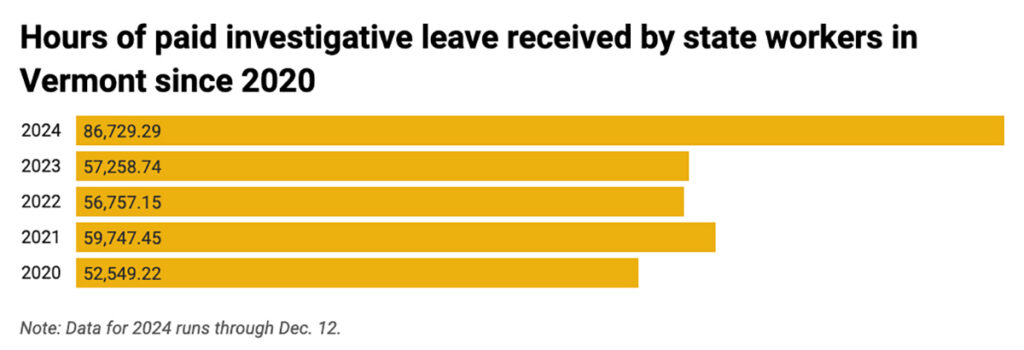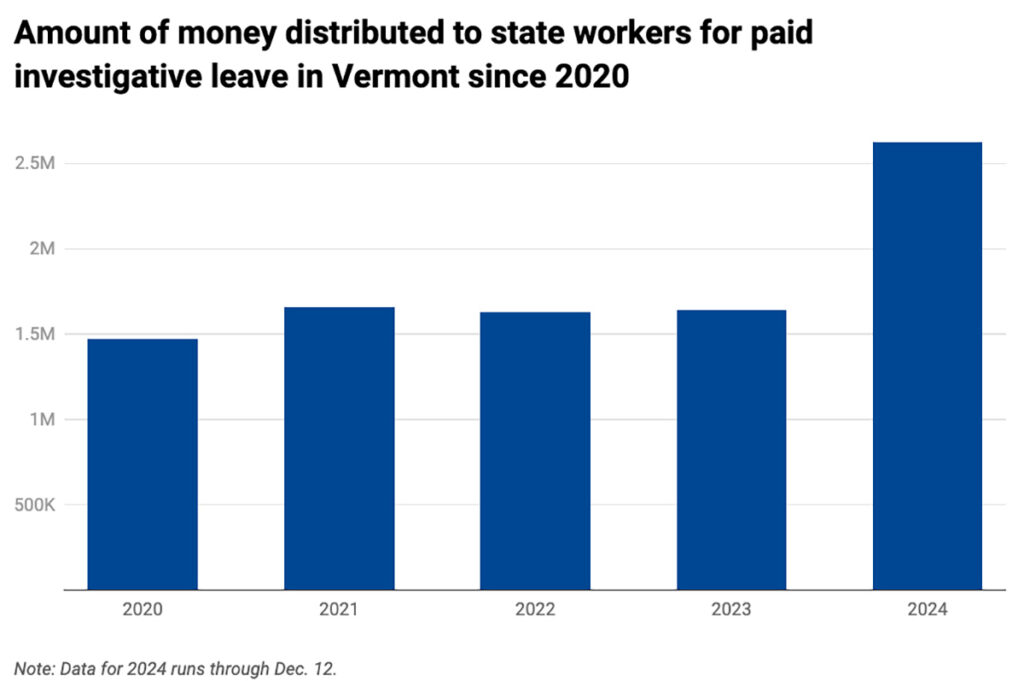By Ethan Weinstein / VTDigger
State records show that since the start of 2020, taxpayers have funded more than $9 million in wages for state employees on paid leave while under investigation for alleged misconduct.
According to Vermont Dept. of Human Resources records obtained through a public records request, the cost of paid investigative leave has increased by 60% this year, rising from $1.64 million in 2023 to $2.62 million as of Dec. 12. State Dept. of Corrections employees account for more than half of those on investigative leave.
“We’re very much hoping the number we’re seeing in 2024 is not the trend going forward,” Human Resources Commissioner Beth Fastiggi said in an interview. “This year is definitely — hopefully — an anomaly.”
A person may be placed on paid leave following an allegation that they’ve broken the state’s employment regulations, such as by engaging in harassment or discrimination. Roughly half of misconduct investigations result in temporary paid relief from duty, according to state data.
Paid investigative leave for state employees has drawn the attention of press and investigators previously, including state Auditor Doug Hoffer.
“Not only is there a cost, but you’re creating a burden on your colleagues who have to fill in for you because you’re not there,” Hoffer said, describing the problems caused by extensive paid leave. While wages paid by the state have stretched above $2.6 million this year, additional benefits like health care add substantially to the overall cost.
Data suggests that many investigations find allegations to be unsubstantiated, and very few result in termination. Yet the total hours of paid investigative leave — more than 86,000 by mid-December, or about 16 weeks per employee under investigative leave — suggest that employees regularly spend months getting paid to sit at home.
Hoffer’s office audited paid leave for state employees during misconduct investigations about eight years ago. He said he was disappointed that, since then, there appeared to be little legislative appetite for addressing the phenomenon.
“I found it frustrating, to be very honest, that the Legislature didn’t seem particularly interested,” he said.
Temporary relief from duty can end in a variety of ways. An employee may be reprimanded or suspended. They could reach a negotiated agreement with the state. Or, as has occurred in a plurality of cases in recent years, the investigation could determine the alleged misconduct is unsubstantiated.
Fastiggi said she’s never seen her department undertake as many investigations as it has this year. Part of the increase comes from a June 2023 change in policy that expanded the types of incidents supervisors have to report from harassment and discrimination to include all forms of alleged misconduct.
Data shows that the overall number of misconduct investigations — not all of which lead to paid leave — has increased steadily since 2020 but even more quickly since June 2023, following the updating of personnel policy.
Fastiggi said human resources investigations involve interviews with witnesses, the complainant, and the person who allegedly committed the misconduct. Staff review emails and other documents, culminating in a report with recommendations. Ultimately, the agency or departmental “appointing authority” — a commissioner, a secretary, or their designee—decides how or whether to reprimand an employee.
The state’s human resources department has an investigative team of six, according to Fastiggi, with about 30 “field staff” who can also assist in misconduct investigations.
When serious discipline is considered—demotion, suspension, or termination—the employee receives written notice and has the opportunity to meet with their department or agency’s appointing authority. Employees also have the opportunity to grieve their punishments, and eventually, cases can reach the Vermont Labor Relations Board.
The Dept. of Human Resources’ data indicates the spike in the cost of paid leave is driven more by the length of leave than the number of employees on leave, though both have increased.
As has long been the case, the Dept. of Corrections has the highest number of employees on leave at the greatest overall cost, with 73 employees on investigative leave at various points this year. That is 7.9% of the department’s total employees, and their investigative leave wages cost more than $1.35 million as of Dec. 12.
According to employee counts from the state Agency of Administration, the Vermont Veterans’ Home, which has had 11 employees on investigative leave this year, has a nearly identical rate of paid leave as the corrections department, at 7.9% of the staff there.
Hoffer, the state auditor, discovered similar trends in his 2017 reports.
Steve Howard, executive director of the Vermont State Employees’ Association, said the biggest complaint he hears about investigative leave is the length of the process, which he called a “morale-killer.”
“They want the investigation to be done as soon as possible,” Howard said of his union’s members.
Howard said that in some instances, employees remain on leave even after investigations are completed. According to Howard, resolving conflict directly between an employee and manager could speed up the process and prevent conflict from escalating, an improvement over the centralized human resources system currently in place.
Given staffing shortages across state government, Howard said it was incumbent on management to resolve investigations quickly. That’s especially true for corrections staff, Howard said, who are particularly overworked.
“They’re under very strict, maybe undue, scrutiny because they’re in one of the most difficult, challenging jobs in all of state government,” he said.
And while Howard wasn’t aware of this year’s spike in investigative leave, he said he’d heard from union members that the Dept. of Human Resources was becoming “very aggressive on discipline.”
Fastiggi didn’t point to one single factor behind 2024’s increasing cost. She noted that the Department of Corrections was “driving” the number of staff on paid leave and that overall volume and the length of investigations were likely factors.
While the Dept. of Human Resources didn’t provide data on the average length of an investigation, the total number of investigations and total number of hours suggests an average of about 640 hours per employee on leave in 2024 — equal to 80 days, or 16 weeks of work. That’s up from about 63 days in 2023.
The length of investigations is increasing slightly faster than the overall number of paid leave investigations, which rose from 113 in 2023 to 135 by mid-December 2024.
By Dec. 12 of this year, 68 investigations involving paid leave had been resolved in 2024, according to the department. Of those, 25 resulted in unsubstantiated findings, 19 led to supervisory feedback, and three fell under the category “termination/involuntary.” Other resolutions included suspensions, oral reprimands and stipulated agreements (six instances) — negotiated resolutions between employer and employee.
Former Secretary of Human Services Mike Smith tried to do away with stipulated agreements within his agency’s departments around 2020. They’ve since been used with much less frequency, data indicates.
Fastiggi didn’t point to one single factor behind 2024’s increasing cost. She noted that the Department of Corrections was “driving” the number of staff on paid leave, and that both overall volume and the length of investigations were likely factors.
But investigations take time, and the more serious allegations take longer to investigate and adjudicate, according to Fastiggi.
“We want to make sure all employees have due process, as well as ensuring we have safe workplaces for our employees,” she said.


Courtesy Natalie Williams/VTDigger, Vt Dept of Human Resources
Charts track hours (left) and number of state employees (right) that received investigative leave over the past five years. Data runs through Dec. 12, 2024.

Courtesy Natalie Williams/VTDigger, Vt Dept of Human Resources
Chart shows the amount of money distributed to state employees that received investigative leave over the past five years since 2020. Data runs through Dec. 12, 2024.




